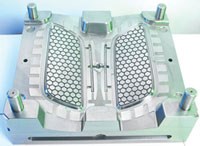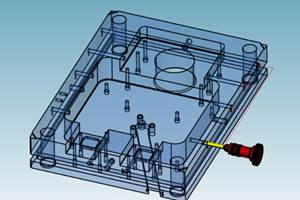Perfecting the Moldmaking Process
One mold manufacturer’s secret to staying ahead: obtaining a full understanding of the entire molding process by cutting and shooting molds in their own shop, and investing in today’s machining technology to strengthen a niche in complex moldmaking.
“There’s more to moldmaking than just cutting steel,” says George Kasper, president of Innovative Mold Inc. (Washington, MI). “You have to understand the full process to know how your work influences the end product and also to see where the industry is going. This is what led us to complex molds, such as two-shot rotationals. We wouldn’t be able to produce these new types of products if we didn’t invest in state-of-the-art technology, like our Makinos.”
Complex Moldmaking
Innovative Mold was started in 1989 by George Kasper and his brother Dave in a small rental space with a few small mills and two grinders. “We saw an opportunity in the small dimensional tools market and relied on our reputation and broad understanding of moldmaking to move into this niche,” says Dave. “Small details can severely affect the quality of a finished part in complex moldmaking,” notes George. “By providing injection processes in the shop, we learned that details while machining the mold must be accurate to 10 thousandths of an inch or parts can turn out deformed.”
Innovative owns two injection molding machines and has injection molders on staff. This setup allows molds to be tested the day they’re completed and assists in perfecting the moldmaking process. This experience in moldmaking and the injection process led them to produce more complex molds, including two-shot rotational molds.
“Two-shot rotationals reduce the cost per part produced and achieve better part accuracy,” explains Dave. “Our equipment was able to produce these complex molds, but parting-line inaccuracies were forcing extensive labor and spotting times. In order to compete on price and improve part quality, we had to look at high-performance machine tools.”
Achieving Accuracy
Two-shot rotational molds pushed Innovative to look at machining centers that could handle the features and exacting details of such molds, while reducing dependence on EDM and long leadtimes.
The first Makino purchase was two VMCs: SNC64 and S56 in 2003. The SNC64 worked as their graphite machine, providing electrodes for their sinker EDMs, which they still relied on at that time. The S56 VMC was their introduction to hard milling, showing them the full benefits of high-speed milling. To keep up with increasing business, the company later purchased additional machines: V56 and V77 VMCs and an EDNC85 Ram EDM.
“Since adding the Makinos to our shop floor, we’ve seen drastic improvements in both standard and two-shot rotational molds,” says Quinn Sova, Innovative’s CNC department manager. “We’ve almost eliminated benching, where the product is not seen by the consumer because molds come out of the machines with finished part quality in nearly every operation, and spotting has been reduced by up to 80 percent. This has a huge impact on our labor costs and our ability to deliver molds and prototype parts to our customers much more quickly.”
Innovative now takes on more orders, including those that require deadlines it couldn’t have achieved prior. “For example, we just completed a 200-ton rotational mold, spotting it in one day, when that type of mold used to take us one to two weeks to spot,” adds Sova.
“Without our Makino VMCs, we would be out of business,” says Dave. “We’ve also reduced labor on our single-shot molds, saving us enough time to bring in overflow machining from mold and die shops, including hard milling applications in 48-plus Rockwell that others aren’t able to handle.”
Two-shot rotational molds run only on the Makinos to ensure transitioning lines are eliminated and the injection processes are run smoothly. The machines have provided everything Innovative expected and more—changing their cavity and core milling to EDM ratio from 50-50 to 90-10 and nearly eliminating all EDM processes. The EDNC85 is the only EDM left in the shop and provides the exacting accuracies needed for molds with very deep ribs and tight corner radii that can’t be milled.
Putting Molding Knowledge to the Test
Word of Innovative’s abilities traveled quickly, leading to an order for an automotive grille piece that put their injection molding knowledge to the test.
The grille mold was constructed of P20 steel and featured complex ribs 50 thousandths of an inch wide, 350 thousandths of an inch deep and 20 thousandths of an inch corner radius. The two-cavity mold was machined on the V77 using a 0.8-mm ball endmill.
In order to produce a finished part in the required deadline, Innovative had to complete the process without any EDM. Prior to their machining investments, a finished part such as this would have required three days of EDM and three days of spotting. The new V-series VMCs were able to save 100 hours in processing time.
“Many shops say they can machine this mold, but not without manual labor,” says Dave. “We were able to finish the mold with nearly zero spotting time.”
As Innovative receives more orders, they have begun expanding to other industries. A recent order for a medical part was placed, presenting another challenge. The mold was machined with a 40 thousandths of an inch ball endmill using a half-degree profile cutter on the V56, chosen for accuracy and ability to direct-mill complex features. Once completed, the mold underwent only one hour of spotting press time.
“The big advantage many foreign competitors have over NA operations is their low labor costs," says George, "but with the right technology in place, we can beat their quality every time, and when you add in the fast turnaround times we can provide, we’re a better value—not to mention our prices go down as our labor goes down.
“The tooling process is about quality, delivery and prices,” explains George, “and by investing in high-performance machines and understanding the whole process, we’re able to provide all three, securing our ability to bring in business for the future.”
Related Content
CAM Automation Increases Mold Production, Quality
Mold builder switches CAM software package after 20 years to take advantage of innovative programming strategies that reduce mold machining programming and processing times.
Read MoreOEE Monitoring System Addresses Root Cause of Machine Downtime
Unique sensor and patent-pending algorithm of the Amper machine analytics system measures current draw to quickly and inexpensively inform manufacturers which machines are down and why.
Read MoreLarge Hybrid Steel Insert Solves Deformation, Dimensionality, Cycle Time Problems
DMLS printers using metal additive powders selected by Linear AMS to produce high-quality, accurate, consistent 3D-printed mold components with certification and traceability.
Read MoreIntegrated CAD/CAM Streamlines Electrode Manufacture, Improves Quality
A focus on electrode design and automation helps toolroom improve efficiency, reduce tooling costs and deliver higher quality products.
Read MoreRead Next
A.J. Tool Co. Inc.: Niche Moldmaking Meets High Expectations
Top-notch customer service combined with loyal, hardworking employees that work together toward continuous improvement land this moldmaker the MoldMaking Technology 2006 Leadtime Leader Award: Small Shop.
Read MoreHow to Use Strategic Planning Tools, Data to Manage the Human Side of Business
Q&A with Marion Wells, MMT EAB member and founder of Human Asset Management.
Read MoreHow to Use Continuing Education to Remain Competitive in Moldmaking
Continued training helps moldmakers make tooling decisions and properly use the latest cutting tool to efficiently machine high-quality molds.
Read More

















.jpg;maxWidth=300;quality=90)








